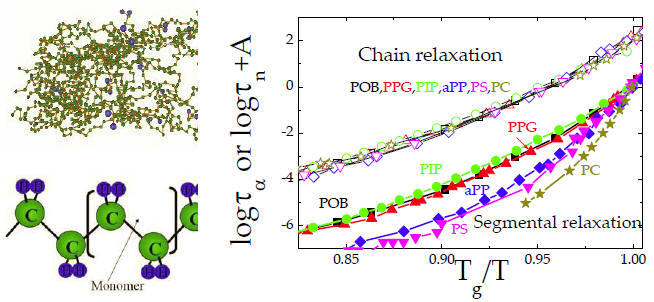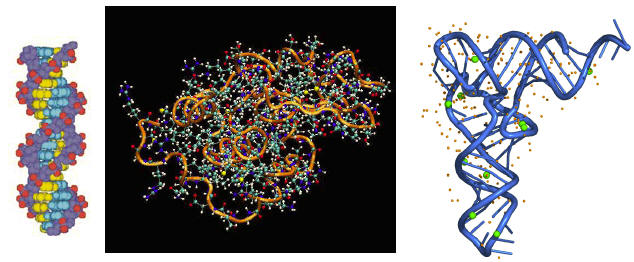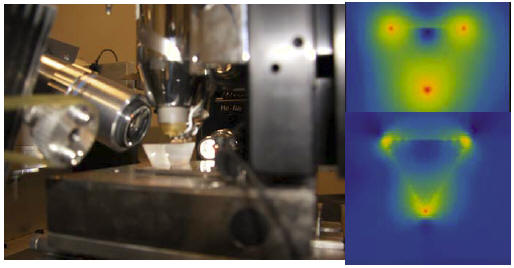Our Projects
Research in our group is focused primarily on experimental studies of Dynamics of Soft Materials and Molecular Biophysics. We are developing fundamental understanding of physical and chemical phenomena in Soft Matter and applying this knowledge to design of novel materials and technologies for different applications from energy to bio-medical fileds. Research in our group can be divided on four major topics: (i) Glass Transition and Polymer Dynamics; (ii) Dynamics of Biological Macromolecules; (iii) Nano-composite and Nano-structured Materials; (iv) Nano-optics and Plasmonics.

Glass Transition and Polymer Dynamics
Molecular motion is the key to many macroscopic properties of soft materials (polymers, colloids, glass-forming and biological systems, etc.). The main goal of our studies in this direction is fundamental understanding of molecular motions and their relationship to macroscopic properties of polymers and other soft materials. Among the major topics, we study the glass transition phenomenon, viscoelastic and mechanical properties, electrical conductivity, influence of chemical structure of the molecules on the dynamics and macroscopic properties of the materials. We use the developed knowledge for design of novel materials for energy applications. We study dynamics using various experimental techniques, including light and neutron scattering and dielectric spectroscopy.
Recent Most Important Publications
L. Hong, B. Begen, A. Kisliuk, V.N. Novikov and A. P. Sokolov,“Influence of pressure on fast picosecond relaxation in glass-forming materials”, Phys. Rev. B 81, 104207 (2010).
A. P. Sokolov and K. S. Schweizer, Resolving the mystery of chain friction mechanism in polymer liquids, Phys. Rev. Lett. 102, 248301 (2009)
L. Hong, P. D. Gujrati, V.N. Novikov, A.P. Sokolov, “Molecular cooperativity in the dynamics of glass forming systems: A new insight”, J.Chem.Phys. 131, 194511 (2009).
L. Hong, A. B. Begen, Kisliuk, S. Pawlus, M. Paluch, A.P. Sokolov, “Influence of Pressure on Quasielastic Scattering in Glasses: Relationship to the Boson Peak”, Phys. Rev. Letters 102, 145502 (2009).
K. Kunal, C.G. Robertson, S. Pawlus, S. F. Hahn, A. P. Sokolov, Role of chemical structure in fragility of polymers: a qualitative picture, Macromolecules 41, 7232 (2008).
L. Hong, B. Begen, A. Kisliuk, C. Alba-Simionesco, V.N. Novikov, A.P. Sokolov, Influence of density (pressure) on the boson peak in polymers, Phys.Rev.B 78, 134201 (2008).
K. Niss, B.Begen, B. Frick, J. Ollivier, A. Beraud, A. Sokolov, V. Novikov, C. Alba-Simionesco, Influence of pressure on the boson peak: Stronger than Elastic Modulus Transformation, Phys.Rev. Letters 99, 055502 (2007).
A.P. Sokolov, V.N. Novikov, Y. Ding, Why many Polymers are so Fragile. J.Phys.Cond.Matt. 19, 205116 (2007).
Y. Ding, A.P. Sokolov, “Breakdown of Time Temperature Superposition Principle and Universality of Chain Dynamics in Polymers”, Macromolecules 39, 3322 (2006).
V.N. Novikov, Y. Ding, A.P. Sokolov, “Correlation of fragility of supercooled liquids with elastic properties of glasses”, Phys.Rev.E 71, 061501 (2005).
V.N. Novikov, A.P. Sokolov, ” Poisson’s ratio and fragility of glass-forming liquids “, Nature 431, 961 (2004).

Dynamics of Biological Macromolecules
Activity and function of biological systems are defined by their dynamics. Understanding the basic parameters that control molecular motions in biological systems, and understanding the relationship between molecular dynamics and biological functions are the main goals of our research in this direction. Among major topics, we also study role of solvents in protein dynamics, activity and stability and we are developing formulations for long-term preservation of biological molecules. We use neutron, light scattering and dielectric spectroscopy, and we actively collaborate with groups performing MD-simulations.
Recent Most Important Publications
S. Khodadadi, J. H. Roh, A. Kisliuk, E. Mamontov, M. Tyagi, S. A. Woodson, R. M. Briber, A. P. Sokolov, Dynamics of Biological Macromolecules: Not a Simple Slaving by Hydration Water, Biophys.J. 98, 1321 (2010).
S. Khodadadi, A. Malkovskiy, A. Kisliuk, A.P. Sokolov, A broad glass transition in hydrated proteins, BBA – Proteins and Proteomics 1804, 15 (2010).
J. H. Roh, R. M. Briber, A. Damjanovic, D. Thirumalai, S. A. Woodson, A. P. Sokolov, Dynamics of tRNA at Different Levels of Hydration. Biophys.J. 96, 2755 (2009).
S. Pawlus, S. Khodadadi and A. P. Sokolov, Conductivity in Hydrated Proteins: No Signs of the Fragile-to-Strong Crossover, Phys.Rev.Lett. 100, 108103 (2008).
Sheila Khodadadi, Sebastian Pawlus, Alexei Sokolov, Influence of Hydration on Protein Dynamics: Combining Dielectric and Neutron Scattering Spectroscopy Data. J. Phys. Chem. B 112, 14273 (2008).
S. Khodadadi, S. Pawlus, J.H. Roh, V. Garcia Sakai, E. Mamontov, A.P. Sokolov, The Origin of the Dynamic Transition in Proteins, J.Chem.Phys. 128, 195106 (2008).
Gokhan Caliskan, Robert M. Briber, D. Thirumalai, Victoria Garcia-Sakai, Sarah A. Woodson, Alexei P. Sokolov, “Dynamic Transition in tRNA is Solvent Induced”, J.Amer.Chem.Soc. 128, 32 (2006).
J. H. Roh, J. E. Curtis, S. Azzam, V. N. Novikov, I. Peral, Z. Chowdhuri, R. B. Gregory and A. P. Sokolov, “Influence of Hydration on the Dynamics of Lysozyme”, Biophys. J. 91 2573-2588 (2006).
J.H. Roh, V.N. Novikov, R.B. Gregory, J.E. Curtis, Z. Chowdhuri, A.P. Sokolov, “Onsets of Anharmonicity in Protein Dynamics”, Phys.Rev.Lett. 95, 038101 (2005).
G. Caliskan, D. Mechtani, S. Azzam, J.H. Roh, A. Kisliuk, M.T. Cicerone, S. Lin-Gibson, I. Peral and A.P. Sokolov, Protein and Solvent Dynamics: How Strongly Are They Coupled?, J.Chem.Phys. 121, 1978 (2004).

Nano-composite and Nano-structured Materials
Addition of small nano-particles to polymers can tremendously affect their properties. We study the influence of nano-fillers (carbon nano-tubes, silica and polymeric particles, graphene) on mechanical and electrical properties of polymers, their dynamics and glass transition. We also study how confinement to small volume (various nanostructures) affects mechanical properties and dynamics of the materials. We analyze various kinds of nano-structures, including polymeric and biological (e.g. viruses).
Recent Most Important Publications
Wenhui Yi, Andrey Malkovskiy, Yongqian Xu, Xiao-Qian Wang, Alexei P. Sokolov, Marisabel Lebron-Colon, Michael A. Meador, Yi Pang, Polymer conformation-assisted wrapping of single-walled carbon nanotube: The impact of cis-vinylene linkage. Polymer 51, 475 (2010).
Y. Ding, S. Pawlus, A.P. Sokolov, J.F. Douglas, A. Karim, C.L. Soles, Dielectric Spectroscopy Investigation of Relaxation in C60-Polyisoprene Nanocomposites, Macromolecules 42, 3201-3206 (2009).
R.D. Hartschuh, S.P. Wargacki, H. Xiong, J. Neiswinger, A. Kisliuk, S. Sihn, V. Ward, R.A. Vaia, and A.P. Sokolov, How rigid are viruses. Phys.Rev.E 78, 021907/1-9 (2008).
Pang, Yi; Meador, Michael; Sokolov, Alexei; Yi, Wenhui; Lebron, Marisabel; Malkovskiy, Andrey, Wrapping of Single-Walled Carbon Nanotubes by a p-Conjugated Polymer: The Role of Polymer Conformation-Controlled Size Selectivity, J. Phys. Chem. B 112, 12263-12269 (2008).
T.-E. Chang, A. Kisliuk, S.M. Rhodes, W. J. Brittain, A.P. Sokolov, Conductivity and Mechanical Properties of Well-dispersed Single-wall Carbon Nanotube/Polystyrene Composite, Polymer 47, 7740-7746 (2006).
R. D. Hartschuh, A. Kisliuk, V. Novikov, A. P. Sokolov, P. R. Heyliger, C. M. Flannery, W. L. Johnson, C. L. Soles, W. L. Wu, “Acoustic Modes and Elastic Properties of Polymeric Nanostructures”, Appl. Phys. Letters 87, 173121-1-3 (2005).
T.E. Chang, L.R. Jensen, A. Kisliuk, R.B. Pipes, R. Pyrz, A.P. Sokolov, “Microscopic mechanism of reinforcement in single-wall carbon nanotube / polypropylene nanocomposite”, Polymer 46, 439-444 (2005).

Nano-optics and Plasmonics
We are developing scanning nano-Raman spectroscopy based on the apertureless near-field optics. It employs gigantic local enhancement of electrical field of light by plasmonic (particular metallic) structures. We already achieved Raman imaging of semiconducting structures with spatial resolution ~20 nm, far beyond the diffraction limit of light. We are also developing plasmonic structures for molecular-level sensing based on surface-enhanced Raman scattering.
Recent Most Important Publications
A.V. Malkovskiy, V.I. Malkovsky, A.M. Kisliuk, C.A. Barrios, M.D. Foster, A.P. Sokolov, “Tip-induced heating in apertureless near-field optics”, J. Raman Spectr. 40, 1349-1354 (2009).
Carlos A. Barrios, Andrey V. Malkovskiy, Alexander M. Kisliuk, Alexei P. Sokolov, Mark D. Foster, Highly Stable, Protected Plasmonic Nanostructures for Tip Enhanced Raman Spectroscopy (TERS), J. Phys. Chem. C 113, 8158-8161 (2009).
N. Lee, R.D. Hartschuh, D. Mehtani, A. Kisliuk, M.D. Foster, A.P. Sokolov, J.F. Maguire,M. Green, “High Contrast Scanning Nano-Raman Spectroscopy of Silicon”, J.Raman Spectr. 38, 789-796 (2007).
D. Mehtani, N. Lee, R. D. Hartschuh, A. Kisliuk, M.D. Foster, A. P. Sokolov, J.F. Maguire, “Scanning Nano-Raman Spectroscopy of Silicon and Other Semiconducting Materials”, In: Tip Enhancement, Eds. S. Kawata and V.M. Shalaev (Elsevier, Amsterdam, 2007), pp. 177-203.
D Mehtani, N Lee, R D Hartschuh, A Kisliuk, M D Foster, A P Sokolov, F Čajko and I Tsukerman, “Optical properties and enhancement factors of the tips for apertureless near-field optics”, J. Optics A: Pure and Appl. Optics 8, S183-S190 (2006).
D. Mehtani, N. Lee, R. D. Hartschuh, A. Kisliuk, M.D. Foster, A. P. Sokolov, J. F. Maguire, Nano-Raman Spectroscopy with Side-illumination Optics, J. Raman Spectr. 36, 1068-1075 (2005).